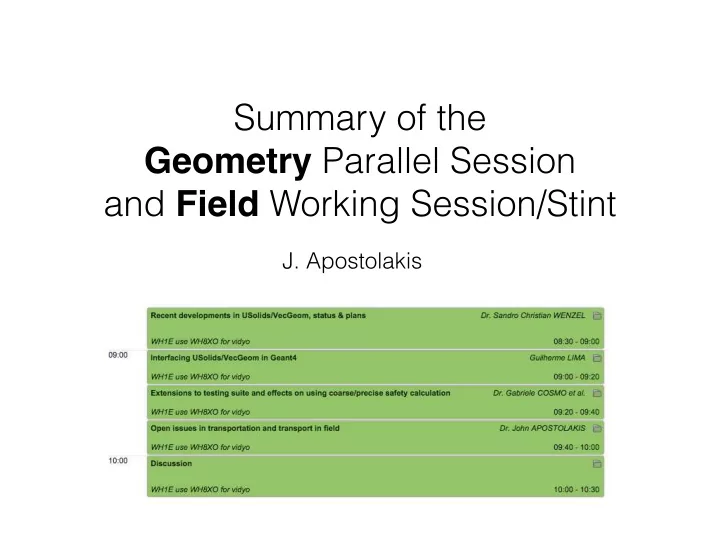

Summary of the Geometry Parallel Session and Field Working Session/Stint J. Apostolakis
VecGeom = Evolved USolids Recent Developments in USolids/VecGeom + Many-Particle API Status + Plans + Geometry Model / Navigation Sandro Wenzel / CERN-PH-SFT Vec SIMD/GPU support = Geom complete geometry modeler Main components of VecGeom AIDA1 USolids Geometry Modeller „Shapes“ Navigation Box, Tube,... LogicalVolume NavigationState PlacedVolume Navigator scalar API vector API Transformations scalar API vector API double DistanceToOut(Vector3D double ComputeStep(Vector3D, const &p, Vector3D const &d) Vector3D) void ComputeStep(...“multi-track“ interface...) void DistanceToOut(„multitrack-interface“) This talk: focus on aspects relevant for Geant4 (single track functionality)
Algorithmic improvement - a wedge for tubs, cons, sphere, .. ~ a 1 „inside“ „outside“ outside test for point P was so far exclusively done using atan2 ~ n 1 now very fast test using only 2 dot products of 2D vectors ϕ enormously speeding up „Contains“, Safety, ... for many shapes ~ ~ P n 2 Effect of „wedge“ on TubeSegment shape (SafetyToIn and Contains) ~ a 2 1500 time units improved scalar 1125 performance • improved algorithms (avoid atan2) 750 VecGeom scalar 375 USolids ROOT VMP G4 ROOT 0 Geant4 DistanceToIn SafetyToIn Contains USolids VecGeom ScalarAPI VecGeom ManyParticle API
Accelerating Navigation in VecGeom recent R&D activity to improve navigation with a focus on algorithms that can benefit from SIMD vector units MBWheel_1N (~700 volumes); most complex element in CMS detector A global performance evaluation dir G4 ROOT VecGeom y 21.5s 12.7s 5.9s z 10.7s 6.58s 4.09s time to obtain the X-Ray image for the CMS calorimeter (VecGeom timing not yet using latest navigators)
Integration of VecGeom into Geant4 Integrating VecGeom into Geant4 Guilherme Lima (Fermilab) for the VecGeom Group ● What is it? It means that we can run “any Geant4 job” using solids and algorithms from the VecGeom library – ...uses VecGeom shapes when available, if not uses the USolids versions then the Geant4 ones – no changes are needed in user/application code other than turning on a few compilation switches – VecGeom shapes: only scalar algorithms are used – no parallelized SIMD processing of tracks! ● How is it done? – VecGeom was designed to be USolids-compatible – Existing USolids interface was used, e.g. G4Box → G4UBox → UBox → (VecGeom) SimpleBox
VecGeom integration how-to Testing with a complex detector polycones ● FullCMS test in geant4 tests repository ● Built agains geant4.10.2.beta ● CMS geometry loaded from a GDML 9le ● Identi9ed some missing features polycone's bounding tube – e.g. points on surface from polycone's Inside() ● Some pathological cases tracked and 9xed – negative Rmin in polycone bounding tube, negative safeties, missing tolerances, … tolerance added to Rmax and ● Current status subtracted from Rmin – if non-zero – 9rst batch of shapes available – choice of shapes based on a full CMS model – ready: box, trapezoid, tube, cone, polycone, polyhedra, with native phi -wedges and Rmin where appropriate ● tested under FullCMS conditions
Testing suite VecGeomPolycone UTubs UTrd (GetPointOnSurface Test) (X-ray profile) (Rays in SurfaceNormal Test) USolids and VecGeom Extensions to testing suite and Extended testing suite effects on using coarse/precise Unit tests ShapeTester safety calculation On Run Time or Jenkins Tatiana Nikitina, CERN PH/SFT for developing shapes Tatiana Nikitina, CERN PH/SFT On behalf of the Geant4 Geometry WG Offline mode Jenkins-ready On behalf of the Geant4 Geometry WG & VecGeom team & VecGeom team Extensive testing suite : ShapeTester ShapeTester DistanceToIn() accuracy Geant4 tests Root tests - SBT(solid batch test) CheckShape: - SurfaceChecker -ShapesDistances() - OpticalEscape -ShapesSafety() a - SurfaceVisTest -ShapeNormal() dir - testDistanceAccuracy.cc … Possibility to test shape on Run Time Extensive Testing Suite b Testing Suite for USolids and VecGeom :ShapeTester Geant4+USolids+Root tests New 'X-Ray Scan' Test Point ‘b’ located on surface + Visualisation and options for debugging + All shapes are included ∣ ∣ ∣∣ Accuracy = DistanceToIn(a,dir) − a – b
ShapeTester Comparing UCons vs VecGeom Cone implementations to GetPointOnSurface() cross-check answers ShapeTester X-Ray Scan VecGeom Cone Safety studies Rays What next ? Crossed_distance Grid - Specific test for precise Safety - Changes in interface are needed, if we want to call Precise and Coarse safety on each step
J. Apostolakis OPEN ISSUES IN • 1. Optical processes TRANSPORTATION AND PROPAGATION IN FIELD • Problem with the exit normal in presence of coincident surfaces • 2. Key Problem in Propagation in EM field • ATLAS - Particles think they are in poly-cone too long • ALICE - Crashes with negative step size • Both linked to Multi Level Locator - a type of G4V Intersection Locator • G4V Intersection Locator role is to confirm and refine a candidate intersection point. • Three implementations - challenges • “Simple” Locator - ‘linear’ = slow • Multi-Level Locator - adds ‘bi-section’ = complex • Brent Locator - adds quadratic conv. = MLL++
4th-Halving 3rd-Halving 2nd try - linear (slow convergence) 1st A DIFFICULT CASE • The algorithm must cope with challenging cases such as the one above. • Track just misses a surface, but keeps on almost grazing it • The complex code has been challenging to make robust • But potentially found two remaining issues for ALICE
New Methods of Field Integration 1. Dense output and FSAL 2. Nystrom steppers with dense output 1. Somnath BANERJEE & 2. Jason SUAGEE (Students in Google Summer of Code 2015)
Runge-Kutta Integration in Geant4 Geant4 uses Runge-Kutta methods to simulate trajectory of particles Dense output - or interpolation 6 computed points in a circular trajectory Calling 100 times between each pair of points, to give “Dense” output Interpolated result
Worst Cost Bogacki Shampine 45 CashKarp45 Best Range of most interest Relative error 10 -2 10 -6 10 -10 10 -14
Recommend
More recommend